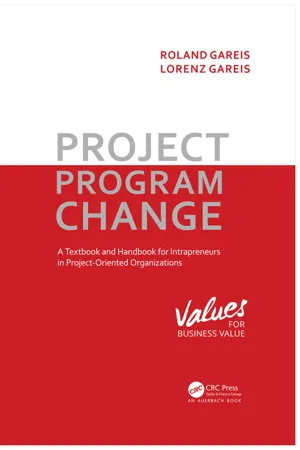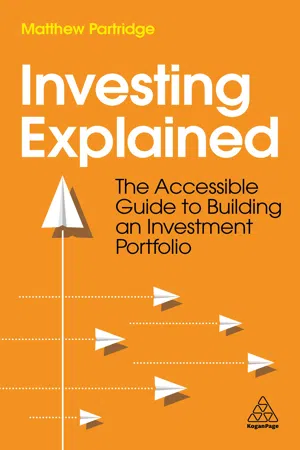Business
Investing
Investing involves allocating money with the expectation of generating a return or profit in the future. It typically involves purchasing assets such as stocks, bonds, real estate, or mutual funds. The goal of investing is to grow wealth over time through the appreciation of the invested capital or through income generated by the assets.
Written by Perlego with AI-assistance
Related key terms
3 Key excerpts on "Investing"
- eBook - ePub
- Roland Gareis, Lorenz Gareis(Authors)
- 2018(Publication Date)
- Taylor & Francis(Publisher)
Investments may relate to various objects—namely, to a product or service, a market, the organization, the personnel, the infrastructure, the financing, and a stakeholder relation. Therefore, unlike in accounting, the definition of an investment used here is not limited to depreciable fixed assets.Definition: InvestmentAn investment is defined as a chain of business processes required to ensure an organization’s capacity to provide services. A differentiation may be made between product or service-related investments, market-related, organization-related, personnel-related, infrastructure-related, financing-related, and stakeholder-related investments.Investment Types
In accordance with the structural and contextual dimensions of organizations defined above, investment types can be differentiated as follows:- product or service-related investments (e.g., developing and selling a product),
- market-related investments (e.g., developing and serving a market),
- organization-related investments (e.g., developing and using an organization),
- personnel-related investments (e.g., developing and deploying personnel),
- infrastructure-related investments (e.g., developing and operating ICT infrastructure),
- finance-related investments (e.g., an initial public offering), and
- stakeholder-related investments (e.g., developing and using a supplier relation).
The general life cycle of an investment object includes the phases of planning, implementing, operating or using, and any subsequent decommissioning of an investment object. The life cycle of an investment object begins once the investment decision is taken. The life cycle of an industrial plant, for example, includes the following chain of business processes: “constructing the industrial plant”, “operating the industrial plant”, “maintaining the industrial plant”, and “decommissioning the industrial plant”. The upstream business process “conceptualizing the industrial plant investment” provides a temporal context for this investment.Fig. 3.4 - H. Kent Baker, John R. Nofsinger, Andrew C. Spieler(Authors)
- 2020(Publication Date)
- Emerald Publishing Limited(Publisher)
You also need to understand what stocks are and how they work. Be aware that stock Investing involves risk, including the potential loss of your initial investment. There are no guarantees except that markets fluctuate over time. No investment strategy is always right. The best you can hope for is to be right most of the time. Learning how to invest in stocks takes time and effort, but it’s worthwhile because knowledge and experience create wealth opportunities. After becoming familiar with Investing basics, you should gradually improve your skills to avoid costly mistakes.If you’re like many investors, owning stocks in some form is likely to be a cornerstone of your Investing strategy. For example, roughly half of adult Americans own stocks, either directly through individual stocks or indirectly through mutual funds, ETFs, pensions, or retirement plans. The indirect approach doesn’t require individual stock picking on your part. Although the wealthiest 1% of Americans hold nearly 40% of stocks and the wealthiest 10% of American families hold about 84% of the nation’s stocks, stock ownership is not just for the wealthy. Savvy investors know that having stocks in their portfolios can help them build wealth providing they are willing to bear risk over a sufficient time to weather market declines and reap the rewards of long-term gains.This chapter tries to demystify the stock market and discusses some basics of stock Investing. It focuses on Investing directly in publicly traded stocks. Chapters 5 and 6 examine indirect Investing especially through mutual funds, ETFs, and retirement plans. These investment vehicles are a great way to start Investing, especially for beginners and those who initially have little money to invest.2.1. WHAT DO THE FOLLOWING TERMS MEAN – SAVING, Investing, GAMBLING, TRADING, AND SPECULATING?
Financial terms can be confusing. For example, are you familiar with the expression: “Investing in the stock market is just like gambling at a casino”? If so, you may confuse Investing with gambling. Although both activities involve risk, they have distinct differences. Let’s clarify the meaning of several financial terms.“How many millionaires do you know who have become wealthy by Investing in savings accounts? I rest my case.” Robert G. Allen- Saving. Saving
- eBook - ePub
Investing Explained
The Accessible Guide to Building an Investment Portfolio
- Matthew Partridge(Author)
- 2022(Publication Date)
- Kogan Page(Publisher)
01The basics of Investing
SummaryInvesting is putting your money to work so that it grows. To do this you need to work out your financial goals, sort out your finances so you can start saving regular amounts of money and then start Investing it in assets like shares and bonds (with the balance between the two depending on your investment horizon). Over time, such a strategy should ensure that you can accumulate sufficient money to more than meet your needs. This is particularly important in the case of retirement because, with firms providing less generous pensions, and governments around the world constantly increasing the retirement age, you will need to take responsibility for your financial future.1. Why do I need to bother with Investing?
Whenever I reveal to people that I’m a financial journalist, I get one of three reactions.Some people try and get me to reveal the secret of making a fortune in the stock market. Others start ranting about their bank, or the latest financial scandal, as if I’m responsible. Finally, some people’s eyes glaze over and they politely say ‘that sounds interesting’ before changing the subject. (Though one person has been blunt enough to simply say, ‘What a boring job.’)Obviously, I don’t agree with this last sentiment, since I find following the twists and turns in the financial markets fascinating. But it’s true that, to quote Nicholas Cage in Matchstick Men, ‘For many people, money is a foreign film without subtitles.’ And there’s nothing wrong with that. However, there’s no escaping the fact that sticking your head in the sand about money isn’t an option in today’s world.Unless you’re planning on living like a monk, you will have financial goals. That could be to enjoy a comfortable retirement, or to buy a house, or to go travelling, or to pay for school fees (or all of the above). And if you want to meet those financial goals, there’s no way round it: we have to make our money work for us.
Index pages curate the most relevant extracts from our library of academic textbooks. They’ve been created using an in-house natural language model (NLM), each adding context and meaning to key research topics.


